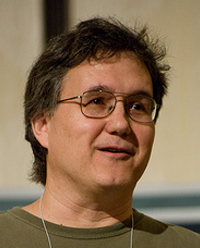Henry Chadwick Award: Tom Ruane
This article was written by Mark Armour
This article was published in Spring 2016 Baseball Research Journal
A prized member of the SABR family for more than 25 years, TOM RUANE’s broad knowledge and interests have allowed him to contribute to many committees, especially Baseball Records, Statistical Analysis, Biographical Research, and the Biography Project. He received the Bob Davids Award, SABR’s highest individual honor, in 2009. A longtime board member and stalwart of Retrosheet, Tom has been involved in many of its most noteworthy efforts, including the design and implementation of its website.
 Tom has spent nearly his entire life in the idyllic town of Poughkeepsie, New York, in the Hudson River Valley. Like many of us, he developed his love of baseball from playing it as a child and stuck with it even as his skills left him, as they inevitably do. Aside from a brief childhood fling with the Twins, his rooting loyalty has shamelessly bounced between the Mets and Yankees depending largely on the two teams’ places in the standings at a given time.
Tom has spent nearly his entire life in the idyllic town of Poughkeepsie, New York, in the Hudson River Valley. Like many of us, he developed his love of baseball from playing it as a child and stuck with it even as his skills left him, as they inevitably do. Aside from a brief childhood fling with the Twins, his rooting loyalty has shamelessly bounced between the Mets and Yankees depending largely on the two teams’ places in the standings at a given time.
Tom received a BA in English (Creative Writing) from SUNY New Paltz in 1976, but smartly hedged his bets with a BS in Computer Science from Union College in 1980. He was granted employment as a computer programmer for IBM in 1980 and, defying the volatility in the industry, has remained there ever since. He continued writing—his short stories appeared in magazines and journals throughout the 1980s, and he even shopped around a novel—but he eventually gave up this dream in favor of starting his family. He married Eileen Travis in 1988, and the couple has raised two (very tall) boys: Joe and Pat, both frequent SABR convention attendees.
As someone who loved baseball and understood what computers could do, Tom almost inevitably began creating his own baseball (and football) simulations, which improved his programming skills while also furthering his own understanding of how baseball teams score and prevent runs. Once he discovered the Bill James Baseball Abstracts and The Hidden Game of Baseball, he became interested in doing his own research, and of course he had the necessary skills to do so.
Tom joined SABR in 1991, and a few years later began extensive research into how teams were constructed throughout the twentieth century. That project resulted in several articles in The Big Bad Baseball Annual, and more importantly became the genesis of an online transactional database that Tom and others have regularly expanded and corrected. It is now being maintained and improved at Baseball-Reference.com.
By the late 1990s Tom had become a very active member of SABR’s online listserv. If you asked a research question on SABR-L in those years, Tom often was the one who answered it, and his answers were usually small pieces of research, detailed and organized enough that the original question and several potential follow-up questions had been answered. Often Tom would not wait for questions to be asked, but would simply post answers to his own questions: What team had the most home runs hit by players in their final season? The simple answer was the 1968 New York Yankees, but Tom was never satisfied with the simple answer, so readers of SABR-L got lots of tables and methodology. In 1998 Tom attended his first SABR convention, and has been a valuable part of the SABR scene ever since.
Sometime in 1997 Tom began volunteering for Retrosheet, including the laborious and necessary proofing of event files. His participation continued to grow until it became his primary research outlet, and he became a Retrosheet board member in 2004. Tom’s primary focus has been the expansion of Retrosheet’s website from primarily a repository for play-by-play data files and the specialized software that could be used to manipulate it to a place for baseball fans to go to find textual play-by-play for tens of thousands (soon hundreds of thousands) of games. A few years later Tom helped start and manage Retrosheet’s Box Score Project, an effort to create online box scores which, as of 2016, is complete back to 1913. Tom also conducts his own studies using Retrosheet data, and publishes them all on their website.
Tom has done all of this with selfless dedication, kindness, and good humor. He has been one of the leading lights of the baseball research community for twenty years and, fortunately, shows every indication that he will remain so for some time to come.
To learn more about the Henry Chadwick Award, click here.


